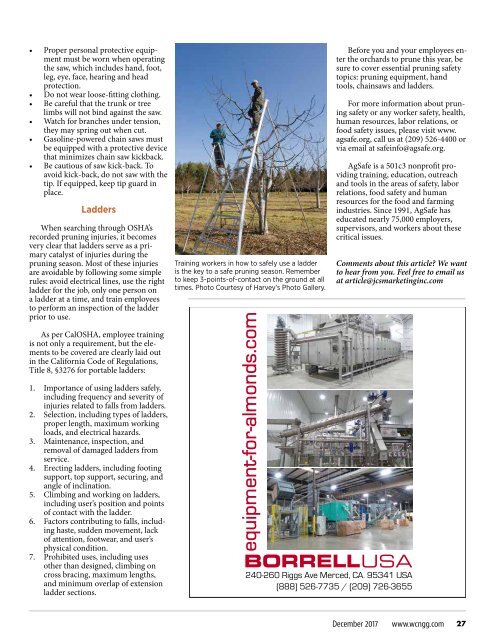WCN_Dec17WEB
Create successful ePaper yourself
Turn your PDF publications into a flip-book with our unique Google optimized e-Paper software.
• Proper personal protective equipment<br />
must be worn when operating<br />
the saw, which includes hand, foot,<br />
leg, eye, face, hearing and head<br />
protection.<br />
• Do not wear loose-fitting clothing.<br />
• Be careful that the trunk or tree<br />
limbs will not bind against the saw.<br />
• Watch for branches under tension,<br />
they may spring out when cut.<br />
• Gasoline-powered chain saws must<br />
be equipped with a protective device<br />
that minimizes chain saw kickback.<br />
• Be cautious of saw kick-back. To<br />
avoid kick-back, do not saw with the<br />
tip. If equipped, keep tip guard in<br />
place.<br />
Ladders<br />
When searching through OSHA’s<br />
recorded pruning injuries, it becomes<br />
very clear that ladders serve as a primary<br />
catalyst of injuries during the<br />
pruning season. Most of these injuries<br />
are avoidable by following some simple<br />
rules: avoid electrical lines, use the right<br />
ladder for the job, only one person on<br />
a ladder at a time, and train employees<br />
to perform an inspection of the ladder<br />
prior to use.<br />
As per CalOSHA, employee training<br />
is not only a requirement, but the elements<br />
to be covered are clearly laid out<br />
in the California Code of Regulations,<br />
Title 8, §3276 for portable ladders:<br />
1. Importance of using ladders safely,<br />
including frequency and severity of<br />
injuries related to falls from ladders.<br />
2. Selection, including types of ladders,<br />
proper length, maximum working<br />
loads, and electrical hazards.<br />
3. Maintenance, inspection, and<br />
removal of damaged ladders from<br />
service.<br />
4. Erecting ladders, including footing<br />
support, top support, securing, and<br />
angle of inclination.<br />
5. Climbing and working on ladders,<br />
including user’s position and points<br />
of contact with the ladder.<br />
6. Factors contributing to falls, including<br />
haste, sudden movement, lack<br />
of attention, footwear, and user’s<br />
physical condition.<br />
7. Prohibited uses, including uses<br />
other than designed, climbing on<br />
cross bracing, maximum lengths,<br />
and minimum overlap of extension<br />
ladder sections.<br />
Training workers in how to safely use a ladder<br />
is the key to a safe pruning season. Remember<br />
to keep 3-points-of-contact on the ground at all<br />
times. Photo Courtesy of Harvey’s Photo Gallery.<br />
Before you and your employees enter<br />
the orchards to prune this year, be<br />
sure to cover essential pruning safety<br />
topics: pruning equipment, hand<br />
tools, chainsaws and ladders.<br />
For more information about pruning<br />
safety or any worker safety, health,<br />
human resources, labor relations, or<br />
food safety issues, please visit www.<br />
agsafe.org, call us at (209) 526-4400 or<br />
via email at safeinfo@agsafe.org.<br />
AgSafe is a 501c3 nonprofit providing<br />
training, education, outreach<br />
and tools in the areas of safety, labor<br />
relations, food safety and human<br />
resources for the food and farming<br />
industries. Since 1991, AgSafe has<br />
educated nearly 75,000 employers,<br />
supervisors, and workers about these<br />
critical issues.<br />
Comments about this article? We want<br />
to hear from you. Feel free to email us<br />
at article@jcsmarketinginc.com<br />
December 2017<br />
www.wcngg.com<br />
27


















